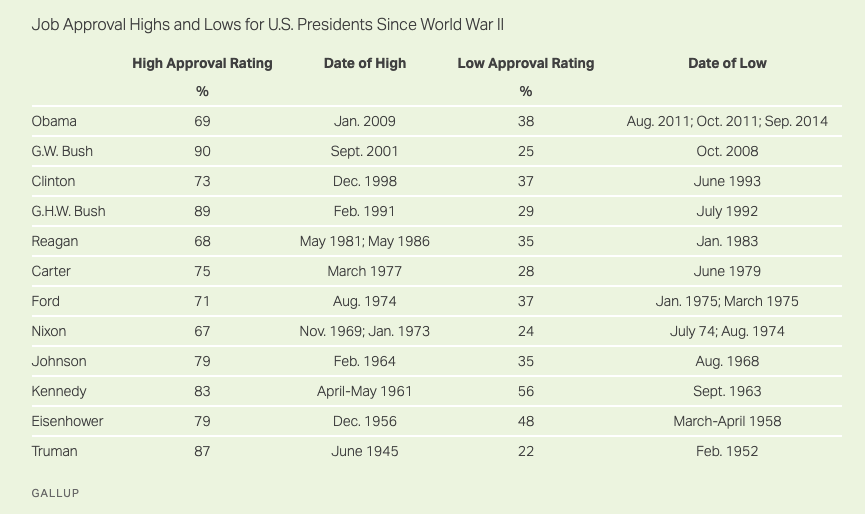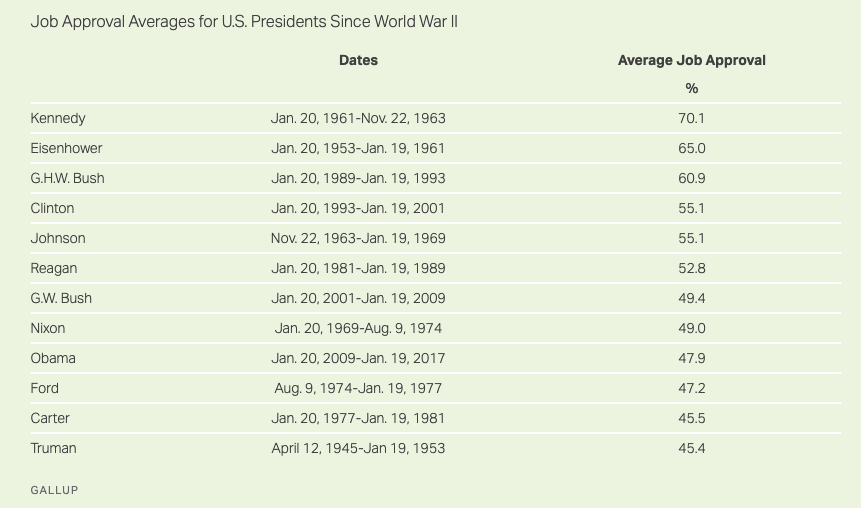Through months of impeachment proceedings, Democrats, with the help of a parade of witnesses, have hammered away at President Trump for abusing power. Yet as the House prepares to vote on impeaching him, Trump’s approval rating is virtually unchanged from before the process started — neither cratering from the negative news or benefiting from any large-scale backlash against impeachment.
This has become a pattern for Trump, whose approval rating (while historically low) is the most stable in history — or at least since Gallup started measuring presidential approval during the Harry Truman presidency. Since taking office, Trump has never polled higher than 46% or lower than 35%, meaning his approval has always stayed within a narrow 11-point range. That’s a stark contrast to prior presidents, who have typically seen wide swings in approval over the course of their presidencies.
To be sure, other presidents have served longer than Trump, allowing more time for their ratings to fluctuate. But that can’t really explain the Trump phenomenon. Prior to Trump, the narrowest range of approval was John F. Kennedy, whose consistently strong approval rating fluctuated 27 points — from a low of 56% to a high of 83%. At this point, Trump has served as president longer than JFK did before his assassination.

On the other extreme, both Truman and George W. Bush saw their approval ratings swing an incredible 65 points. Truman’s approval peaked in June 1945 at 87% shortly after V-E Day and sunk to as low as 22% as a result of a weakening economy and the failures of the Korean War. Bush saw his approval soar to 90% in the wake of the Sept. 11 attacks and crash to 25% after years of the Iraq War and, eventually, the financial crisis.
Yet in the face of a bombardment of news, Trump’s approval rating has hardly budged. It seems that opinions on Trump are set like they have never been for any previous president, impervious to changes based on negative news, or successes, such as unemployment remaining at a 50-year low. After Bill Clinton was impeached, the backlash helped drive his approval to 73% — the high point of his presidency. But Trump has seen no similar effect, one way or the other.
In addition to the stability of Trump’s approval ratings, it should be noted that they are also historically low. To date, Trump’s approval rating has averaged just 40%. Prior to Trump, the lowest averages were Truman (at 45.4%) and Jimmy Carter (at 45.5%).

The unique nature of Trump’s approval ratings makes it a bit tricky to rely on the numbers to help predict the outcome of the 2020 presidential race. On the one hand, the stability of his approval rating gives us a better sense than usual of what his popularity is likely to be next November. On the other hand, it’s difficult to know how voters will reconcile such a strong job market with their clear misgivings about Trump.

